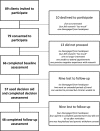Right choice, right time: Evaluation of an online decision aid for youth depression
- PMID: 27748004
- PMCID: PMC5513008
- DOI: 10.1111/hex.12510
Right choice, right time: Evaluation of an online decision aid for youth depression
Abstract
Background: Appropriate treatment for youth depression is an important public health priority. Shared decision making has been recommended, yet no decision aids exist to facilitate this.
Objectives: The main objective of this study was to evaluate an online decision aid for youth depression.
Design: An uncontrolled cohort study with pre-decision, immediately post-decision and follow-up measurements.
Setting and participants: Young people (n=66) aged 12-25 years with mild, mild-moderate or moderate-severe depression were recruited from two enhanced primary care services.
Intervention: Online decision aid with evidence communication, preference elicitation and decision support components.
Main outcome measures: The main outcome measures were ability to make a decision; whether the decision was in line with clinical practice guidelines, personal preferences and values; decisional conflict; perceived involvement; satisfaction with decision; adherence; and depression scores at follow-up.
Results: After using the decision aid, clients were more likely to make a decision in line with guideline recommendations (93% vs 70%; P=.004), were more able to make a decision (97% vs 79%; P=.022), had significantly reduced decisional conflict (17.8 points lower (95% CI: 13.3-22.9 points lower) on the Decisional Conflict Scale (range 0-100)) and felt involved and satisfied with their decision. At follow-up, clients had significantly reduced depression symptoms (2.7 points lower (95% CI: 1.3-4.0 points lower) on the Patient Health Questionnaire nine-item scale (range 0-27)) and were adherent to 88% (95% CI: 82%-94%) of treatment courses.
Discussion and conclusions: A decision aid for youth depression can help ensure evidence-based, client-centred care, promoting collaboration in this often difficult to engage population.
Keywords: adolescents; depression; patient decision aids; shared decision making; young adults.
© 2016 The Authors. Health Expectations Published by John Wiley & Sons Ltd.
Figures
References
-
- Gore FM, Bloem PJ, Patton GC, et al. Global burden of disease in young people aged 10‐24 years: a systematic analysis. Lancet. 2011;377:2093–2102. - PubMed
-
- beyondblue . Clinical practice guidelines: Depression in adolescents and young adults. 2010. Available from: http://resources.beyondblue.org.au/prism/file?token=BL/0890. Accessed October 3, 2016.
-
- National Institute of Clinical Excellence . Depression in Children and Young People: Identification and Management in Primary, Community and Secondary Care. London: The British Pyshcological Society; 2005. - PubMed
-
- Crickard EL, O'Brien MS, Rapp CA, Holmes CL. Developing a framework to support shared decision making for youth mental health medication treatment. Community Ment Health J. 2010;46:474–481. - PubMed
Publication types
MeSH terms
LinkOut - more resources
Full Text Sources
Other Literature Sources
Medical



